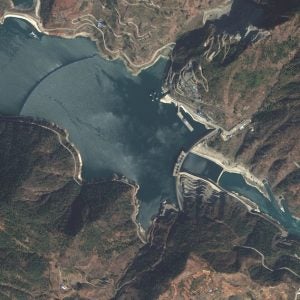
Dam inspections should be a critical component of an infrastructure healthcare plan, writes Rodney W. Eisenbraun, PE, and Laura LaRiviere, PE
The American Society of Civil Engineering (ASCE) 2013 Report Card grades the overall condition and performance of US dams a lowly D – largely due to the increasing number of dams added to the high hazard potential list each year. Currently, the average age of the 84,000 dams in the country is 52 years old. According to the report, by 2020, 70% of the total dams in the United States will be over 50 years old.
As dams continue to age, they may not be able to safely withstand infrequent, yet likely natural events such as large floods and earthquakes, their outlets and spillway may be severely eroded such that they threaten the safety of the dam and their foundations and embankments can be more likely to develop seepage or stability deficiencies. In addition, many of these dams were constructed using less-stringent design criteria for low hazard potential dams due to the lack of development below the dam when it was first constructed. However, with increasing population and greater development below dams, low hazard potential dams can change to high hazard potential dams very quickly.
The challenge for owners and operators is to assure that their aging dams are able to handle the anticipated loads that are likely to occur from age, natural disasters and continued development. Dam safety inspections performed by knowledgeable inspectors are a cost effective way to manage the risks that dam ownership pose to dam owners – and much like regular health checks to a medical doctor, dam inspections are a vital, affordable step in awareness that could help owners avoid mishaps or prevent disaster.
Fast-track inspections
While some of the nation’s dams are owned and operated by federal, state and local governments, 69% are owned by a private entity. The federal government owns 3225 dams, or approximately 4% of the nation’s dams, and the US Army Corps of Engineers owns 694 dams. Federal Energy Regulatory Commission regulates 2600 dams.
The remaining dams are not regulated by the federal government, but instead rely on state dam safety programs for regulatory oversight.
State dam safety programs have primary responsibility and permitting, inspection and enforcement authority for 80% of the nation’s dams. Therefore, state dam safety programs bear a large responsibility for public safety. Unfortunately, many state programs lack sufficient resources, and in some cases, enough regulatory authority, to be effective. In fact, each state safety inspector is responsible for on average 207 dams.
Most dam safety organizations and inspection professionals have adopted the hazard potential methodology for dam evaluations. The hazard potential is based solely on the downstream impacts – not the condition of the dam.
For instance, the Federal Emergency Management Agency (FEMA) defines three hazard potential classifications – low, significant and high hazard – to identify a dam’s potential for adverse consequences.
If the loss of one or more human lives is probable following a failure of the dam, then inspectors/engineers assign a high potential hazard classification to the dam. Definitions of the classifications vary considerably across federal, state and local authorities.
Emergency dam assessments: the case of Colorado
Colorado has one of the most advanced dam safety programs in the country. ASCE rated Colorado as having one of the highest rates of Emergency Action Plans (EAPS) for high and significant hazard potential dams in place in the nation. Record rainfall in September 2013, and the subsequent devastation, has further reshaped Colorado’s dam safety program.
In September, heavy rain caused extreme flooding of nearly 4500 square miles, killing eight and damaging or destroying as many as 2000 homes. The floods also washed out hundreds of miles of roads and left many small mountain towns completely cut off from neighboring communities.
In response, the Colorado Dam Safety Office coordinated the largest dam inspection program in state history, which included the inspection of over 200 low, significant and high hazard potential dams in 10 days, mostly along the South Platte River and its tributaries. Over 100 engineers, including five from Kleinfelder, volunteered their time to inspect dams located in the hardest hit areas.
Each team used a Dam Inspection Checklist prepared by the Colorado Dam Safety Office. The inspectors checked each dam for seepage, voids, soil displacement, excessive vegetation, damage to the outlet works and spillway, cracking and general erosion.
Of note, throughout Colorado, all high hazard potential dams withstood the flood event. However, nine low hazard dams failed as did a number of small ponds, ultimately contributing to the devastation – emphasizing the need for dam owners to perform regular inspections as a way to help prevent disaster.
While the Colorado Dam Safety Office was able to complete the inspection of all 200 dams using volunteers from various agencies and engineering companies, the success of the program provides some valuable insight into the speed and quality with which dam inspections can be performed.
An ounce of prevention could prevent dam disaster
As noted in the beginning, dam safety inspections are a cost effective way to manage the risks that dam ownership poses to dam owners. The inspection may reveal that there are no issues with the dam or reveal obvious deficiencies or even a potential change in hazard classification so the owner can address the problem.
When it comes to performing dam inspections, owners should look carefully at dam inspection experience. All engineers are not the same. A qualified consultant who has inspected hundreds of dam all over the country will have seen most every potential problem.
For owners with multiple dams, performing the inspections all at once can require far less money and time as a mobilized inspection team can investigate multiple dams in a close timeframe, as compared to one or two every few months.
Just as many individuals manage their health with periodic visits to their physicians to head off problems, a dam safety inspection is the first step in preventative maintenance. Remember, just because you aren’t aware of a problem, doesn’t mean that it doesn’t exist and more importantly the lack of awareness doesn’t remove you from responsibility and the possible consequences.
Benjamin Franklin once said an ounce of prevention is worth a pound of cure. In the world of dams, an ounce of prevention in the way of regular inspections and maintenance could prevent disaster.
Need help with a dam inspection or have more questions? Look into state-focused development training programs that emphasize dam maintenance and emergency action plans. Supported by expert consultants, these programs educate owners about dam ownership responsibilities.
Author information
Rodney W. Eisenbraun, PE, is the Vice President and Dam & Hydropower Segment Leader for Kleinfelder. He can be reached at (303) 953-6906 Laura A. LaRiviere, PE, is a Water Resources Engineer for Kleinfelder. She can be reached at (303) 304-2660






